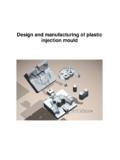Transcription of L MOLD IN NEW CONSTRUCTION AND ITS COMPLEXITIES
1 Page 1 of 8 LUMBERYARD mold IN NEW CONSTRUCTION AND ITS COMPLEXITIES Peter Sierck, CIEC, CMC, CMRS, Principal Connie Jenkins, , Mycologist Andrew Jordan, , Environmental Consultant ET&T, 5431 Avenida Encinas, #F, Carlsbad, CA 92008, Tel: 760-804-9400 Lumberyard mold , the dark, fluffy, patches on new lumber, has become an issue in new CONSTRUCTION . When the presence of lumberyard mold is discovered, indoor air quality professionals (IAQ) are frequently called upon during the CONSTRUCTION process to assess, assist and answer mold -related questions. Various stakeholders such as the developers, risk managers, banking representatives, contractors, and other persons with an interest in the project may raise questions regarding the presence of fungal growth on the lumber used during the CONSTRUCTION process and its subsequent liabilities.
2 Design and CONSTRUCTION firms are frequently faced with CONSTRUCTION defect claims that involve mold related problems. CONSTRUCTION defect claims can commonly be accompanied by other claims for property damage, delays, profit losses, interruption of business, breach of contract, or payment disputes. Sometimes mold -related claims can also be accompanied by or evolve into class action lawsuits, where personal injury is declared due to mold exposure and mold related problems. Each year millions of dollars are spent in the United States on mold related problems. All of the parties involved in a new CONSTRUCTION project, such as designers, suppliers, architects, engineers, owners, contractors, developers, etc, are subject to the possibility of facing mold related claims.
3 Risk management tools and steps can prevent or reduce the likelihood of mold related claims and/or problems in the future. 1. What is Lumberyard mold Lumber and other modern building materials found on CONSTRUCTION sites provide potential food sources for fungal growth. Lumberyard mold is a term often used to encompass a wide variety of fungi that are visible on new wood, and wood products. Lumber is differentiated into sapwood and heartwood. Sapwood refers to the area near the bark and heart wood to the center of the tree. Heartwood is more resistant to decay and fungal growth as a result of deposition of chemical substances (a genetically programmed process) and can still chemically react to decay organisms when dead.
4 Heartwood is usually much darker than sap wood and appears in a cross-section as a usually colored circle. Framing lumber and other CONSTRUCTION wood products are usually sap wood. (photo Univ. Wisconsin) All wood in a tree is first formed as sapwood. Its principal functions are to conduct water from the roots to the leaves and to store up and give back, according to the season, the food prepared in the leaves. Sometimes trees need to grow to Lumberyard mold in New CONSTRUCTION and its COMPLEXITIES Page 2 of 8 considerable size before any heartwood begins to form.
5 In building CONSTRUCTION , it is mainly the sapwood section of the lumber which is affected by lumberyard mold and the secondary growth of other fungi. Heartwood Sapwood Based on their ability to penetrate wood tissue, wood inhabiting fungi that can grow in a lumberyard or a building CONSTRUCTION site can roughly be grouped into surface, sap stain and decay fungi. Surface Molds - Microfungi Surface molds can grow on the surface of freshly cut wood and utilize the wood carbohydrates as a nutrient source. Some of these molds can also grow on the hyphae and mycelia of other fungi.
6 Surface molds cause discoloration of the wood surface by their pigmented spores and mycelia, usually they do not damage the wood structure. Sap Stains - Ascomycetes Sap Stain fungi utilize nutrients stored in the sap wood tissue and cause discoloration of wood tissue by their dark pigmented mycelia, spores, and melanin produced by the fungi. Sap stain fungi do not significantly decompose wood cell wall components, but they may reduce the wood strength and increase wood permeability making the wood more vulnerable to further microbial attack.
7 Species such as Ceratocystis, Ophiostoma, and Graphium are common sap stain fungi found on lumber. These fungi are the ones most often identified from the dark, fuzzy growth on the surface of lumber. (Photo University of Wisconsin) Microfungi such as Alternaria and Aureobasidium also can contribute to the sap stain fungi. Wood Decay Fungi Basidiomycetes (Mushrooms) Wood decaying fungi can pose real damage to lumber and wood products. Wood decaying fungi penetrate into wood tissue and destroy the wood structure compromising its structural integrity.
8 They destroy the wood structure by attacking both the sapwood and heartwood of wood and wood products. On lumber, both new and old, basidiomycetes most often appear as white or brown fan shaped patches (mycelial fan). They can also appear as root like structures (Poria incrassata). Lumberyard mold in New CONSTRUCTION and its COMPLEXITIES Page 3 of 8 2. Evaluating Lumberyard Conditions All fungi have four basic elements for growth: suitable temperature, oxygen, food and moisture. Eliminating one of these elements can prevent fungal growth (Scheffer, 1940, 1973).
9 Controlling temperature and oxygen on a CONSTRUCTION site is typically not practical therefore controlling moisture is an effective way of prohibiting or reducing fungal growth. Reducing the moisture content of lumber can help decrease the likelihood of mold formation on the wood selected for the project. Lumber at moisture contents greater than 20% without drying can allow decay fungi to develop (Forrest Products Laboratory, 1999). The type of visible mold growth on lumber can vary from a simple stain, the presence of varying amounts of dark Ceratocystis and/or Ophiostoma mycelia, secondary scavenger fungi such as Trichoderma, Penicillium and Aspergillus or wood decay fungi and its mycelia.
10 We developed a 3-tiered evaluation process for our projects consisting of the following parameters. Visual inspection We conduct a general assessment of the extent and degree of the affected lumber and develop an overall estimate on how much of the wood surfaces are affected by fungal growth. We inspect the three or four accessible sides of a piece of lumber and determine the approximate fungal coverage in percentage (%) of the entire surface area. We summarize the overall affected surface area which commonly varies from , 1%, 2% or 5% of the total lumberyard surfaces.





